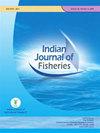Length-weight relationships and relative condition factor of fish species dwelling in the inland saline river, Luni, India, with a note on the associated risks and encounters obstructing the fish diversity and ecosystem services
IF 0.3
4区 农林科学
Q4 FISHERIES
引用次数: 0
Abstract
Luni is an ephemeral and inland saline river flowing through the Thar Desert of India. The present study focusses on the length-weight relationships (LWRs) and condition factor analysis of six native and one invasive alien fish species (Oreochromis mossambicus) collected from the river Luni during the exploratory surveys conducted from October, 2018 to September, 2020. LWRs of native fish species showed negative allometric growth for Aphanius dispar, Cirrhinus mrigalaand Salmostoma bacaila and positive allometric growth for Labeo rohita, Mystus gulio and Systomus sarana. Despite abundant distribution of O. mossambicus in the middle and downstream segments of the river Luni, this study revealed good wellbeing and suitability of this river to native and non-native fish species. This forms the first study that reports the LWRs and Kn value of these fish species from the river Luni, which could be useful for estimating stock characteristics and future evaluation of fish population in this dynamic and fragile ecosystem. Further, results of the present study were also compared with the available literature from nearby and associated ecosystems. The baseline information generated will be helpful in understanding the present status of the fish population and also to carryout ecological studies for their conservation and management in the future.Keywords: Invasive Alien Species, Length-weight relationship, Oreochromis mossambicus, Thar Desert居住在印度鲁尼内陆咸水河中的鱼类的长重关系和相对条件因子,以及阻碍鱼类多样性和生态系统服务的相关风险和遭遇
鲁尼河是一条短暂的内陆咸水河,流经印度塔尔沙漠。本研究的重点是在2018年10月至2020年9月进行的勘探调查中,从鲁尼河采集的六种本地和一种入侵外来鱼类(Oreochromis mossambicus)的长重关系(LWR)和条件因子分析。本地鱼类的LWR显示Aphanius dispar、Cirrhinus mrigala和Salmostoma bacaila的负异速生长,Labeo rohita、Mystus gulio和Systomus sarana的正异速生长。尽管O.mossambicus在卢尼河的中下游河段分布丰富,但本研究表明,该河对本地和非本地鱼类物种具有良好的福祉和适宜性。这是第一项报告鲁尼河中这些鱼类的LWR和Kn值的研究,这可能有助于估计种群特征和未来对这一动态和脆弱生态系统中鱼类种群的评估。此外,本研究的结果还与附近和相关生态系统的现有文献进行了比较。所产生的基线信息将有助于了解鱼类种群的现状,也有助于对其未来的保护和管理进行生态研究。关键词:外来入侵物种;长重关系;莫桑比克Oreochromis mossambicus;塔尔沙漠
本文章由计算机程序翻译,如有差异,请以英文原文为准。
求助全文
约1分钟内获得全文
求助全文
来源期刊

Indian Journal of Fisheries
FISHERIES-
CiteScore
0.90
自引率
20.00%
发文量
0
审稿时长
6-12 weeks
期刊介绍:
Indian Journal of Fisheries is published quarterly by the Indian Council of Agricultural Research (ICAR), New Delhi. Original contributions in the field of Fish and fisheries science are considered for publication in the Journal. The material submitted must be unpublished and not under consideration for publication elsewhere.
Papers based on research which kills or damages any species, regarded as thratened/ endangered by IUCN crieteria or is as such listed in the Red Data Book appropriate to the geographic area concerned, will not be accepted by the Journal, unless the work has clear conservation objectives.
 求助内容:
求助内容: 应助结果提醒方式:
应助结果提醒方式:


